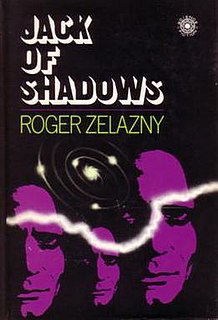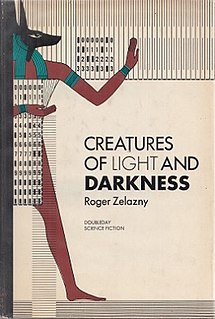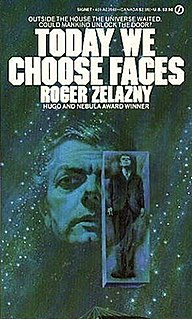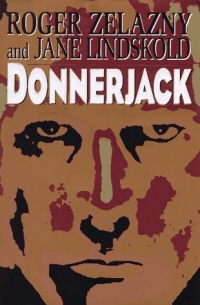
Roger Joseph Zelazny was an American poet and writer of fantasy and science fiction short stories and novels, best known for The Chronicles of Amber. He won the Nebula Award three times and the Hugo Award six times, including two Hugos for novels: the serialized novel ...And Call Me Conrad (1965), subsequently published under the title This Immortal (1966) and then the novel Lord of Light (1967).

Steven Karl Zoltán Brust is an American fantasy and science fiction author of Hungarian descent. He is best known for his series of novels about the assassin Vlad Taltos, one of a disdained minority group of humans living on a world called Dragaera. His recent novels also include The Incrementalists (2013) and its sequel The Skill of Our Hands (2017), with co-author Skyler White.

Jack of Shadows is a science fantasy novel by American author Roger Zelazny. According to him, the name of the book was an homage to Jack Vance. In his introduction to the novel he mentioned that he tried to capture some of the exotic landscapes that are frequent in Vance's work. Zelazny wrote it in first draft, with no rewrites. The novel was serialized in the Magazine of Fantasy and Science Fiction in 1971 and published in book form that same year. It was nominated for a 1972 Hugo Award and finished #4 in the 1972 Locus Poll for Best Novel.

Creatures of Light and Darkness is a 1969 science fiction novel by American writer Roger Zelazny. Long out of print, it was reissued in April 2010. The novel is set in the far future, with humans on many worlds. Some have god-like powers, or perhaps are gods—the names and aspects of various Egyptian gods are used. Elements of horror and technology are mixed, and it has points in common with cyberpunk.

Roadmarks is a science fantasy novel by American author Roger Zelazny, written during the late 1970s and published in 1979.

Jane M. Lindskold is an American writer of fantasy and science fiction short stories and novels.

Doorways in the Sand is a science fiction novel by American writer Roger Zelazny. Featuring both detective fiction and comic elements, it was originally published in serial form in the magazine Analog Science Fiction and Science Fact; the hardcover edition was first published in 1976 and the paperback in 1977. Zelazny wrote the whole story in one draft, no rewrites and it subsequently became one of his own five personal favorites in all his work. Doorways in the Sand was nominated to the Nebula and Hugo awards.

Today We Choose Faces is a 1973 science fiction novel by American writer Roger Zelazny. As originally constructed, Part 1 was an extensive flashback which followed Part 2, but the order of the sections was changed at the request of editor David Hartwell, who felt that the novel worked better in chronological order. Zelazny later wrote, “I was younger then & more in need of the money at the time & couldn’t afford to argue [with] him about it. I still prefer it the way I wrote it.”

The Dream Master (1966), originally published as a novella titled He Who Shapes, is a science fiction novel by American writer Roger Zelazny. Zelazny's originally intended title for it was The Ides of Octember. It won the 1965 Nebula Award for Best Novella.

Deus Irae is a post-apocalyptic science fiction novel started by American author Philip K. Dick and finished with the help of American author Roger Zelazny. It was published in 1976. Deus irae, meaning God of Wrath in Latin, is a play on Dies Irae, meaning Day of Wrath or Judgment Day. This novel was based on Dick's short story "The Great C".

NESFA Press is the publishing arm of the New England Science Fiction Association, Inc. The NESFA Press primarily produces three types of books:

Lord Demon is a fantasy novel by American writer Roger Zelazny, completed in 1999 by Jane Lindskold after his death.

Donnerjack is a science fiction novel begun by American author Roger Zelazny and completed after his death by his companion Jane Lindskold. It was published in 1997.

To Die in Italbar (1973) is a science fiction novel by American writer Roger Zelazny. To Die in Italbar follows Mr. H, a man who needs only to touch someone to heal or hurt them, during a deadly galactic pandemic.

This Immortal, serialized as ...And Call Me Conrad, is a science fiction novel by American author Roger Zelazny. In its original publication, it was abridged by the editor and published in two parts in The Magazine of Fantasy and Science Fiction in October and November 1965. It tied with Frank Herbert's Dune for the 1966 Hugo Award for Best Novel.

A Dark Traveling is a science fantasy novel by American writer Roger Zelazny. The story uses teleportation as both fantasy and science fiction elements. It is the only novel he wrote for young adults and one of three books without a heroic protagonist.

Bridge of Ashes is an experimental science fiction novel by author Roger Zelazny. The paperback edition was published in 1976 and the hardcover in 1979. Zelazny describes the book as one of five books from which he learned things "that have borne me through thirty or so others". He states that he "felt that if I could pull it off I could achieve some powerful effects. What I learned from this book is something of the limits of puzzlement in that no man’s land between suspense and the weakening of communication".

The Dark World is a science fantasy novel credited to Henry Kuttner, although his wife C.L. Moore may have been an uncredited collaborator, or possibly even the author. The novel was first published in the July 1946 issue of Startling Stories, then reprinted in the Winter 1954 issue of Fantastic Story Magazine. Its first book edition was issued by Ace in 1965, followed by a British edition by Mayflower Books in 1966. A French translation appeared in 1972. The novel was reprinted in full in Issue #5 of Amberzine in 1992, and also collected in a 1997 paperback omnibus, The Startling Worlds of Henry Kuttner. Roger Zelazny, author of The Chronicles of Amber, credits this book as being one of his primary influences during his youth.

Way Up High is a children's book by American writer Roger Zelazny. It is one of two stories he wrote for children, the other being Here There Be Dragons, and one of three books without heroic protagonists. One thousand copies of each of the two books signed by Zelazny were published in 1992 with illustrations by Vaughn Bodē.
This is a partial bibliography of American science fiction and fantasy author Roger Zelazny.



















